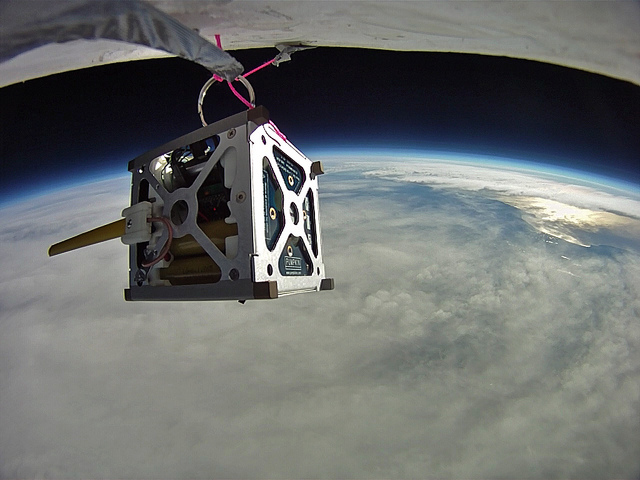PhoneSat — NASA’s smartphone nanosatellite
August 29, 2012

The coffee-cup-size Android-powered PhoneSat during a high-altitude balloon test (credit: NASA Ames Research Center)
NASA’s new PhoneSat project at Ames Research Center will soon demonstrate the ability to launch the lowest-cost and easiest-to-build satellites ever flown in space by using consumer smartphones.
Smartphones already offer a wealth of capabilities needed for satellite systems, including fast processors, versatile operating systems, multiple miniature sensors, high-resolution cameras, GPS receivers, and several radios.
NASA engineers kept the total cost of the components to build each of the three prototype satellites in the PhoneSat project to $3,500 by using only commercial-off-the-shelf hardware and keeping the design and mission objectives to a minimum for the first flight.
Each NASA PhoneSat nanosatellite is one standard CubeSat unit in size and weighs less than four pounds. (A CubeSat is a miniaturized satellite in the shape of a cube that measures approximately 4 inches.)
PhoneSat 1.0
NASA’s prototype smartphone satellite, known as PhoneSat 1.0, is built around the Nexus One smartphone made by HTC Corp., running the Android operating system. The Nexus One acts as the spacecraft onboard computer. Sensors determine the orientation of the spacecraft and the smartphone’s camera can be used for Earth observations. Commercial-off-the-shelf parts include a watchdog circuit that monitors the systems and reboots the phone if it stops sending radio signals.
NASA’s PhoneSat 1.0 satellite has a basic mission goal — to stay alive in space for a short period of time, sending back digital imagery of Earth and space via its camera, while also sending back information about the satellite’s health.
PhoneSat 2.0
NASA’s PhoneSat 2.0 will equip a newer Nexus S smartphone made by Samsung Electronics running Android to provide a faster core processor, avionics, and gyroscopes.
PhoneSat 2.0 also will supplement the capabilities of PhoneSat 1.0 by adding a two-way S-band (microwave) radio to allow engineers to command the satellite from Earth, solar panels to enable longer-duration missions, and a GPS receiver. In addition, PhoneSat 2.0 will add magnetorquer coils — electromagnets that interact with Earth’s magnetic field — and reaction wheels to actively control the satellite’s orientation in space.
The Future of PhoneSat
NASA’s PhoneSat 2.0 will lay the foundation for new capabilities for small-sized satellites while advancing breakthrough technologies and decreasing costs of future small spacecraft.
Expected to launch in 2013, NASA’s upcoming Edison Demonstration of Small Satellite Networks mission — part of the Small Spacecraft Technology Program — will demonstrate the possibility of conducting heliophysics measurements using small spacecraft.
Three NASA PhoneSats systems (two PhoneSat 1.0’s and one PhoneSat 2.0) are scheduled to launch aboard the maiden flight of Orbital Sciences Corporation’s Antares rocket from NASA’s Wallops Flight Facility at Wallops Island, Va., later this year.